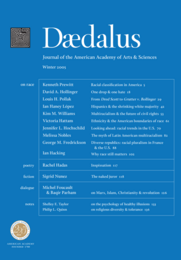Race, law & history: the Supreme Court from “Dred Scott” to “Grutter v. Bollinger”
I start from two points of departure: The first I draw from the contrasting contentions of counsel in a redistricting case argued in the Supreme Court in 1976.1 The case addressed the validity of a 1974 New York statute that redrew state senate and assembly districts in Brooklyn with a view to enlarging the number of districts with “substantial nonwhite majorities.” The attorney general of the United States, exercising a supervisory authority vested in him by the Voting Rights Act of 1965, had assented to the statute. In the Supreme Court, Nathan Lewin, the very able attorney for the white petitioners challenging the statute, argued that drawing district lines with race in mind was unconstitutional. In response to a question from the bench, Lewin acknowledged that drawing district lines with an eye to voters’ political affiliations was permissible. But race was different, Lewin argued: “We think politics is part of the political process. Race is not part of the political process. Race is an impermissible standard.”2
The very able lawyer representing the United States, Solicitor General Robert Bork, responded: “I was astounded when Mr. Lewin said that race is not a part of our political process. Race has been the political issue in this nation since it was founded.”3
My second point of departure relates to W. E. H. Lecky, the Dublin-born scholar whose works ornamented British historiography in the second half of the nineteenth century. Lecky, so we are told, was invited to one of those vast manorial weekends in which, even as late as the Gladstone and Salisbury eras, the great aristocratic houses were wont to spread themselves. Lecky was unacquainted with his hostess, the duchess of something-or-other, but at dinner he nevertheless found himself seated to her left. After Her Grace had exhausted conversation with the guest seated to her right, she turned to Lecky:
“Oh, Professor Lecky, you must remind me. What is it you do?”
“Well, Your Grace, I’m a historian.”
“Goodness, Professor Lecky, that is too bad.”
“I beg your pardon, Your Grace, but I’m not sure that I understand. Why is it too bad that I’m a historian?”
“Well, Professor Lecky, I do think that it’s so much better to let bygones be bygones.”
Perhaps some bygones can be left, like cuttings from the garden, to be raked into small heaps, gathered, and wheelbarrowed to the compost pile. But not the bygones of race. Not in America. Not yet. . . .
Endnotes
- 1This essay, delivered as the 2004 Robert P. Anderson Lecture at Yale Law School in April of 2004, was written in tribute to Charles Hamilton Houston, William Henry Hastie, and Thurgood Marshall. I am indebted to two good friends –Frank Goodman and Victor Brudney– who reviewed this essay in draft and offered valuable criticisms and suggestions that have measurably strengthened the final product.
- 2United Jewish Organizations of Williamsburg, Inc. v. Carey, No. 75-104 (U.S. Sup. Ct., October 6, 1976), transcript of argument, 33.
- 3Ibid., 62. I note, by way of full disclosure, that, representing the NAACP as an intervenor, I too participated in the argument.
